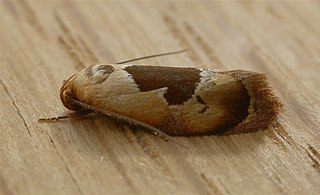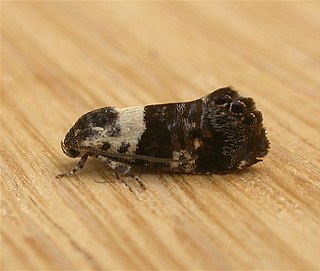
Hoplomorpha camelaea is a moth in the family Oecophoridae first described by Edward Meyrick in 1888. It is found in Australia, where it has been recorded from Victoria, Queensland, New South Wales and the Australian Capital Territory.

Eupselia aristonica is a species of moth of the family Depressariidae. It is found in Australia, where it has been recorded from New South Wales, the Australian Capital Territory, Victoria and Tasmania.

Lichenaula lichenea is a species of moth of the family Xyloryctidae. It is known in Australia from the Australian Capital Territory, New South Wales and Queensland.
Helcystogramma bicuneum is a moth in the family Gelechiidae. It was described by Edward Meyrick in 1911. It is known from north-eastern India and China.
Bida is a monotypic moth genus in the family Xyloryctidae described by Francis Walker in 1864. Its only species, Bida radiosella, described by the same author one year earlier, is found in Australia, where it has been recorded from New South Wales, South Australia, Tasmania, Victoria and Western Australia.
Catoryctis eugramma is a moth in the family Xyloryctidae. It was described by Edward Meyrick in 1890. It is found in Australia, where it has been recorded from New South Wales and Queensland.
Catoryctis nonolinea is a moth in the family Xyloryctidae. It was described by Thomas Pennington Lucas in 1894. It is found in Australia, where it has been recorded from New South Wales and Queensland.
Catoryctis polysticha is a moth in the family Xyloryctidae. It was first described by Oswald Bertram Lower in 1893. It is found in Australia, where it has been recorded from South Australia.
Catoryctis subnexella is a moth in the family Xyloryctidae. It was described by Francis Walker in 1864. It is found in Australia, where it has been recorded from the Australian Capital Territory, New South Wales, South Australia and Tasmania.
Catoryctis tricrena is a moth in the family Xyloryctidae. It was described by Edward Meyrick in 1890. It is found in Australia, where it has been recorded from South Australia, Victoria and Western Australia.
Catoryctis truncata is a moth in the family Xyloryctidae. It was described by Thomas Pennington Lucas in 1902. It is found in Australia, where it has been recorded from New South Wales and Queensland.
Pilostibes basivitta is a moth in the family Xyloryctidae. It was described by Francis Walker in 1864. It is found in Australia, where it has been recorded from New South Wales and Queensland.
Lichenaula undulatella is a moth in the family Xyloryctidae. It was described by Francis Walker in 1864. It is found in Australia, where it has been recorded from New South Wales, Queensland and Western Australia.
Plectophila electella is a moth in the family Xyloryctidae. It was described by Francis Walker in 1864. It is found in Australia, where it has been recorded from New South Wales, Queensland and South Australia.
Xylorycta ophiogramma is a moth in the family Xyloryctidae. It was described by Edward Meyrick in 1890. It is found in Australia, where it has been recorded from Queensland.
Xylorycta parabolella is a moth in the family Xyloryctidae. It was described by Francis Walker in 1864. It is found in Australia, where it has been recorded from New South Wales, South Australia, Tasmania and Victoria.
Eclecta is a monotypic moth genus in the family Depressariidae. Its only species, Eclecta aurorella, has been found in the Australian state of New South Wales. Both the genus and species were first described by Edward Meyrick in 1883.
Barantola pulcherrima is a moth in the family Depressariidae. It was described by Francis Walker in 1864. It is found in New Guinea and Australia, where it has been recorded from Queensland and New South Wales.
Comotechna corculata is a moth in the family Depressariidae. It was described by Edward Meyrick in 1921. It is found in Peru and Pará, Brazil.
Psittacastis pictrix is a moth in the family Depressariidae. It was described by Edward Meyrick in 1921. It is found in Colombia.


